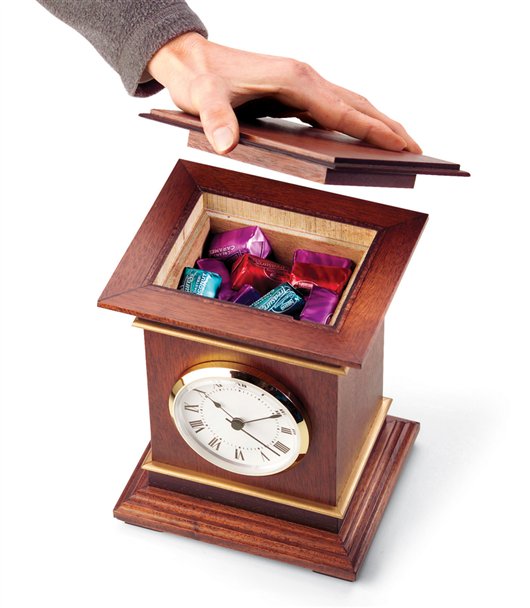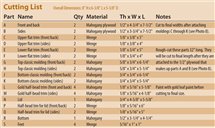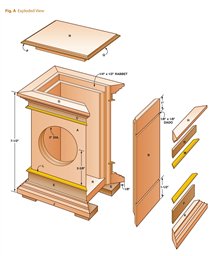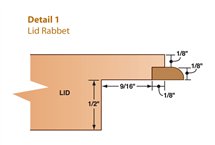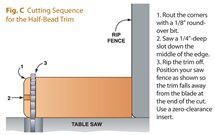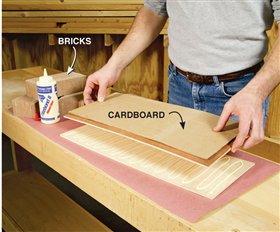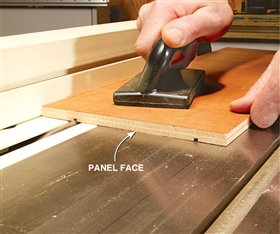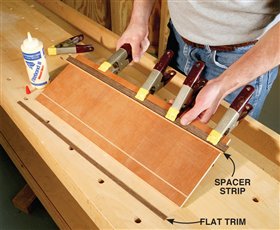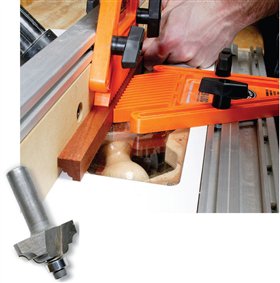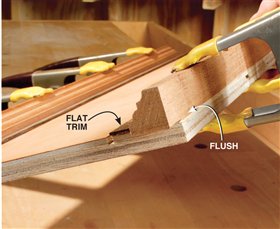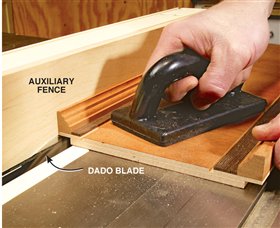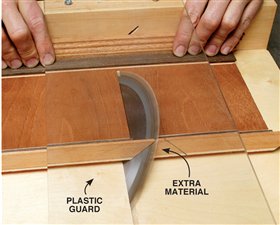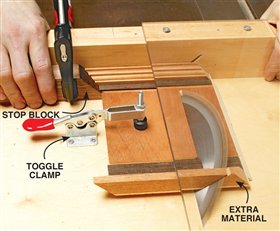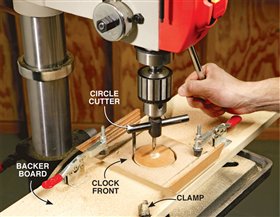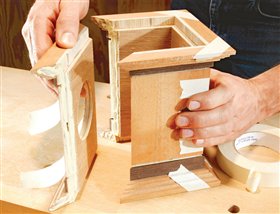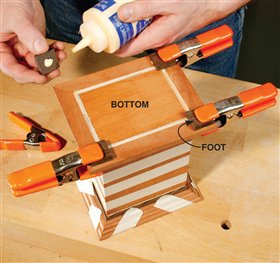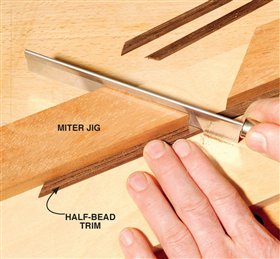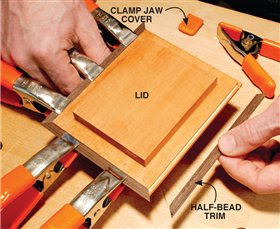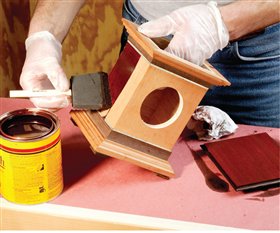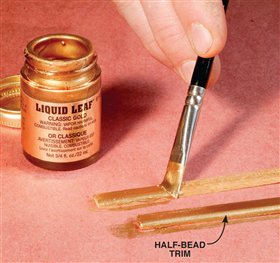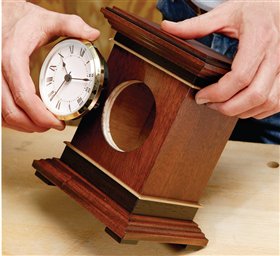This clock holds a secret—a compartment
for candy—and its construction involves a few
secrets as well.Such as this: The case is made from 1/2″-thick
mahogany plywood. You won’t find this material
at most lumberyards, so you’ll be making
your own by gluing together two layers of 1/4″
plywood.
Another secret: You’ll be gluing the moldings
to the plywood case first, then mitering the parts
later. This simplifies the building process and
sure beats mitering all the moldings individually.
Tools and materials
To build this clock, you’ll need a tablesaw,
a planer, a router table and a drill
press. You’ll be using a couple of special
router bits: a classical bead and cove
bit and a 1/8″ roundover bit. You’ll also
need an adjustable circle cutter to cut
the round clock opening (see Sources, below).
The clock is made from Honduras
mahogany plywood and lumber, with
some wenge trim. Wenge (pronounced
wen-gay or wenj) is a dark-brown tropical
hardwood that nicely complements
mahogany’s reddish-brown color.
For the clock case, you’ll need 1/4″-
thick mahogany plywood. It doesn’t take
much, so buy a partial sheet unless you
plan to make several clocks. You’ll also
need a 3/4″ x 6″ x 48″ piece of mahogany
lumber and a chunk of wenge. Buy a
piece of wenge that’s at least 3″ wide
by 32″ long. It’s more than you actually
need, but it’s easier and safer to cut the
parts from a piece this size, rather than
from one that’s smaller.
The battery-powered clock mechanism
is a one-piece insert (see Sources),
which is simply friction-fit into a hole
in the clock front. This makes it easy to
change the batteries or the time.
Laminate the plywood
Cut two 32″ x 8″ pieces of 1/4″ mahogany
plywood (Fig. B, below). Notice
that the grain runs the short dimension
on these parts. Glue these together
to form the 1/2″ mahogany plywood
needed for the clock case (Photo 1).
After the glue has dried, rip the 1/2″
plywood to 7-1/2″ wide on the tablesaw.
Take about 1/4″ off both edges so
they are straight and parallel. Next, cut
the two 1/8″ dadoes in the face of the
plywood (Photo 2, Fig. A, page below).
Attach moldings
and trim
Make the upper and lower flat trim
pieces (C, D, E and F). Place spacer
strips in the small dadoes in the panel
to provide a stop for the flat trim to
push up against, and glue the flat trim
to the 1/2″ plywood panel (Photo 3).
Remove the spacer strips before the
glue dries to prevent them from getting
stuck.
Next cut a strip of mahogany for the
top and bottom moldings (G, H, J and
K). Use the bead and cove router bit to
shape them (Photo 4). Note that the
top molding is 1/8″ thinner than the
bottom molding and they are attached
to the plywood so they mirror each
other (Fig. A). Glue and clamp them to the plywood (Photo 5). The edges of the molding
and the plywood should be flush. If they’re not, wait
until the glue has dried and trim the parts flush on
your tablesaw. Complete the 1/2″ plywood panel by
cutting a rabbet at the top and bottom on the back
side (Photo 6, Fig. A).
Miter the sides
Set your tablesaw blade to 45° and miter some test
boards. Then use a tablesaw sled—or a miter gauge
with a fence—to miter the clock’s four sides. Start by
cutting the sides about 1/4″ oversize (Photo 7). It’s OK
to leave the extra material on one edge; it will be cut off
when you cut the parts to final width (Photo 8). Cut
slowly to avoid chip-out on the moldings. Wenge is
particularly prone to chip-out, but cutting at a slower
rate helps avoid that problem. If the wood does chip,
save the loose piece and glue it back on. Use a toothpick
to apply the glue and masking tape to hold the
chip in place.
Drill the opening for the clock insert into the clock
case front (A, Photo 9). The clock insert is centered
vertically on the case front between the two gold halfbead
trim pieces (L).
Assemble the case
Apply glue to two sides first and hold them together
with masking tape. Add the other two sides one at
a time. Stretch the tape, so it pulls the parts tightly
together (Photo 10). Then glue in the bottom and add
the four feet (S, Photo 11).
Next, make the lid (N). Cut the rabbets on the bottom
of the lid (Detail 1). Check that the lid fits easily
into the rabbet in the top of the clock case.
Make the half-bead trim (L, M, P, Q) that goes
around the case and the lid. This trim is very small,
but is easy to make using our step-by-step cutting
sequence (Fig. C, below). Miter the half-bead trim
that goes around the lid and attach it to the underside of the lid (Photos 12 and 13). You’ll
need some small spring clamps to hold
these trim pieces in place while the glue
dries (see Sources). Set aside the strips
of half-bead trim (L, M) that go around
the case. They will be used later.
Finishing touches
Sand the entire clock case and lid with
180-grit paper and stain it (Photo 14).
A red mahogany stain gives the mahogany
a deep rich tone and helps even
out any color difference between the
plywood and the lumber (see Sources).
After the stain dries thoroughly
(24 to 48 hours), brush on a satin polyurethane
varnish (see Sources).
While the stain and finish dry, paint
the half-bead trim gold (L and M,
Photo 15). Miter it to final length and
glue it into the dadoes on the clock case.
All that’s left now is to install the battery
in the clock mechanism, set the time
and insert the mechanism into the clock
case (Photo 16).
Oh yeah, don’t forget to add the
candy.
Sources
(Note: Product availability and costs are subject to change since original publication date.)
Woodworker’s Supply, woodworker.com,
800-645-9292, Adjustable heavy duty circle
cutter, #829-757; 1″ spring clamps, #125-
033.
MLCS, mlcswoodworking.com, 800-533-9298,
1/4″ classic bead and cove router bit, #6452; 1/8″ round-over router bit, #6350.
Rockler Woodworking and Hardware, rockler.
com, 800-279-4441, Decorator clock face,
#23995.
Jo-Ann Fabric and Craft Stores, joann.com,
888-739-4120, Plaid liquid leaf classic gold,
#5766563.
Woodworkers Source, woodworkerssource.
com, 800-423-2450, 3/4″-thick wenge.
Wood & Shop Inc., woodnshop.com, 314-739-
0001, Mahogany plywood 1/4″ x 2′ x 4′.
Minwax, minwax.com, 800-523-9299 (for
dealer locations), Satin fast-drying polyurethane,
#63000; Red mahogany
stain, #70007.
Cutting List

Fig. A: Exploded View

Detail 1: Lid Rabbet

Fig. B: Plywood Cutting Diagram

Fig. C: Cutting Sequence for the Half-Bead Trim

1. Rout the corners
with a 1/8″ roundover
bit.
2. Saw a 1/4″-deep
slot down the
middle of the edge.
3. Rip the trim off.
Position your saw
fence as shown so
the trim falls away
from the blade at
the end of the cut.
Use a zero-clearance
insert.
This story originally appeared in American Woodworker July 2004, issue #108.

|
|
Click any image to view a larger version.

1. Make your own 1/2″ mahogany plywood for the clock case,
because finding it at a lumberyard can be difficult. Use several
bricks as clamps and a piece of cardboard to protect the
plywood from getting scratched.

2. Cut two 1/8″ dadoes in the face of the plywood panel. A thin
molding that goes all the way around the clock will later be fit
into these dadoes. Use a push block for safety and to maintain
even pressure while sawing.

3. Glue and clamp the flat trim pieces onto the plywood panel.
Put a 1/8″ x 1/4″ spacer strip into the dadoes (without glue)
and push the flat trim up against it. Remove the spacer strip
after you’ve attached the clamps.

4. Rout the top and bottom moldings with a
classical bead and cove router bit. Use feather
boards to hold the molding against the fence
and table for the smoothest cut.

5. Glue and clamp the classic molding tight against the edge of
the flat trim. The molding’s outer side should be flush with the
plywood edge. Trim off any molding or plywood overhang with
your tablesaw.

6. Cut two rabbets in the plywood panel for the lid and bottom.
Put a temporary wooden auxiliary fence on your saw so you can
push the fence right up to the dado blade.

7. Cut one miter on all four case sides with a shop-made sled. Cut
the sides a little extra wide at this step. Pushing more slowly
than normal helps reduce chip-out on the moldings.

8. Miter the sides to final width. Hold each piece in place with a
toggle clamp. This ensures a straight cut and keeps your hands
out of harm’s way.

9. Drill the hole for the clock with a circle cutter. Set the drill press to its
slowest speed and hold the part with two toggle clamps. Secure the
backer board to the drill table with a couple of clamps.

10. Assemble the sides with glue and masking tape. Pull the masking tape
tight and check for gaps along the miters.

11. Glue the bottom into the rabbet that runs around the sides.
Attach the feet 1/8″ in from the edge of the molding.

12. Miter the half-bead trim using a small handsaw and a jig. The
jig is simply two mitered boards glued to a piece of plywood.

13. Glue the half-bead trim into the small rabbet on the bottom
side of the lid. Remove one of the jaw covers from the spring
clamp to provided more pressure on the small trim. Leave the
other jaw cover on to protect the lid’s top from getting dented.

14. Stain the clock case to even out any differences in wood color
between the solid lumber and plywood parts. When the stain
is dry, apply a clear finish.

15. Apply three coats of gold paint to the half-bead trim that
goes around the clock case. Sand between coats to remove
any roughness. Install the trim after the paint is dry.

16. Install the clock mechanism. It’s simply a pressure fit, requiring
no fasteners. |



